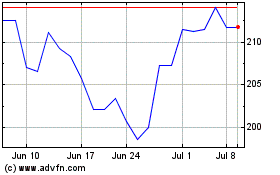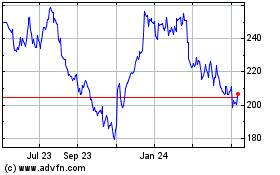Teleflex Reports Study Results of ARROWg+ard® Technology Effectiveness in Preventing Infections & Associated Costs in an Inf...
January 13 2015 - 7:30AM
Business Wire
Peer-Reviewed Published Research Reconfirms
Clinical Benefits and Cost-Effectiveness of Chlorhexidine/Silver
Sulfadiazine-Impregnated CVC
Teleflex Incorporated (NYSE: TFX), a leading global provider of
medical devices for critical care and surgery, announced that newly
published research has reaffirmed the ability of catheters
protected with ARROWg+ard® Technology to reduce both bloodstream
infections and direct costs associated with treating those
infections.1
The ARROW® CVC with ARROWg+ard® Technology outperformed the
unprotected CVC in both infection reduction and total cost per
patient. Within the study, the protected catheter achieved a zero
infection rate per 1,000 catheter days. In contrast, the
unprotected device was associated with a much higher CRBSI rate of
8.61/1,000 catheter days (7.4% of cases). The results were
statistically significant. Additionally, the antimicrobial
protected catheter was also associated with prolonged CRBSI-free
time compared to the unprotected catheter, including dwell times of
up to 25 days without a bloodstream infection.
The study focused only on Central Venous Catheters (CVCs)
inserted into the femoral area. The researchers compared infection
rates and cost-effectiveness of an unprotected CVC versus a
catheter protected with ARROWg+ard® Technology inserted into this
infection-prone region. (ARROWg+ard® Technology is an antimicrobial
protection of chlorhexidine and silver sulfadiazine bonded to the
catheter’s surface to reduce catheter-related bloodstream
infections [CRBSIs]). The research goal was to determine if the
chlorhexidine/silver sulfadiazine CVC could reduce bloodstream
infection rates and reduce the cost of diagnosing and treating an
infection.
The authors undertook the study because previous
cost-effectiveness analyses of antimicrobial catheters included the
cost of extended hospital stays. This cost varies widely from
institution to institution and country to country, limiting the
applicability of the results. For the current study, the authors
included only the costs of CVCs, infection diagnosis and
antimicrobials used to treat patients who developed infections.
These direct expenses, they believed, provide a clearer picture of
the ultimate cost-effectiveness of the protected, antimicrobial
catheter, given its somewhat higher initial cost.
The ARROW® CVC with ARROWg+ard® Technology had sharply lower
CVC-related costs than those associated with the unprotected
catheter. Notably, the cost of an ARROW® CVC with ARROWg+ard®
Technology was 15 times less expensive than an unprotected
catheter. (The cost per catheter day of the protected catheter was
€2.92 ± €1.77 vs. the cost of an unprotected catheter at €18.22 ±
€53.13. The cost was calculated in euros because the study was done
in Spain. As of the press release date, the conversions to dollars
would be $3.48 ± $2.11 vs. $21.70 ± $63.27.)
The study involved patients admitted to the ICU of the Hospital
Universitario de Canarias (Tenerife, Spain) who received one or
more femoral venous catheters. It examined a total of 254 catheters
and 2,195 catheter days. Each patient’s physician made the decision
about whether to use a protected or unprotected catheter and
whether to insert the catheter in the femoral vein.
The study was a retrospective analysis performed and published
by Leonardo Lorente, M.D., Ph.D. and colleagues independent of
Teleflex. Dr. Lorente works in the Department of Critical Care at
Hospital Universitario de Canarias, in Tenerife, Spain.
The peer‐reviewed paper appears in the October 2014 issue of the
American Journal of Infection Control, which is published by APIC,
the Association for Professionals in Infection Control and
Epidemiology.
“We report that the antimicrobial catheter eliminated infections
even though it was used in the femoral access site, which is
typically associated with higher infection rates,” said Lorente.
“This suggests the device might be similarly effective when used in
other sites with high infection risk or with vulnerable patient
populations such as immunocompromised patients.”
Lorente said the results could be helpful to other institutions,
adding, “These findings may interest hospitals who are evaluating
antimicrobial catheters to reduce their bloodstream infection
rates. The fact that the antimicrobial catheter was shown to be
cost-effective should also reassure those institutions about the
economics of antimicrobial CVCs.”
“This study underscores the fact that hospitals can benefit by
looking beyond up-front costs to total treatment costs when
selecting a central venous catheter,” said Jay White, President of
the Teleflex Vascular Access Division. “In the study, the total
costs of using an unprotected catheter were extremely high because
of the infections and related treatment costs. In contrast, the
ARROWg+ard® Technology improved both outcomes and
cost-effectiveness. This study demonstrates that Teleflex can help
hospitals protect their patients and their bottom line.”
More than 30 studies support the ability of ARROWg+ard®
Technology to save lives and reduce costs by reducing infections.
Additional information on the technology can be found at
arrowgard.com and thearrowadvantage.com.
About Teleflex Incorporated
Teleflex is a leading global provider of specialty medical
devices for a range of procedures in critical care and surgery. Our
mission is to provide solutions that enable healthcare providers to
improve outcomes and enhance patient and provider safety.
Headquartered in Wayne, PA, Teleflex employs approximately 11,500
people worldwide and serves healthcare providers in more than 150
countries. Additional information about Teleflex can be obtained
from the company's website at teleflex.com.
Forward-Looking Statements
Any statements contained in this press release that do not
describe historical facts may constitute forward-looking
statements. Any forward-looking statements contained herein are
based on our management's current beliefs and expectations, but are
subject to a number of risks, uncertainties and changes in
circumstances, which may cause actual results or company actions to
differ materially from what is expressed or implied by these
statements. These risks and uncertainties are identified and
described in more detail in our filings with the Securities and
Exchange Commission, including our Annual Report on Form 10-K.
Teleflex, Arrow, and Arrowg+ard are trademarks or registered
trademarks of Teleflex Incorporated or its affiliates.© 2015
Teleflex Incorporated. All rights reserved. MC-000725
References:
1. Lorente L, Lecuona M, Jiménez A, et al. Cost/benefit analysis
of chlorhexidine-silver sulfadiazine-impregnated venous catheters
for femoral access. American Journal of Infection Control, 2014;
42: 1130-1132.
Teleflex IncorporatedJake ElguiczeTreasurer and Vice President,
Investor
Relations610-948-2836jake.elguicze@teleflex.comwww.teleflex.com
Teleflex (NYSE:TFX)
Historical Stock Chart
From Mar 2024 to Apr 2024

Teleflex (NYSE:TFX)
Historical Stock Chart
From Apr 2023 to Apr 2024
